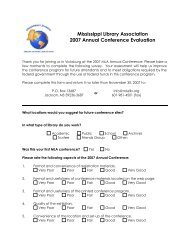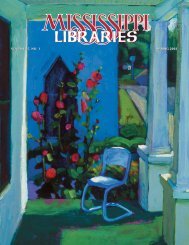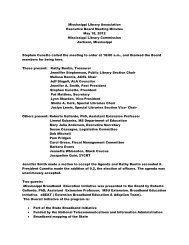Full Text (PDF) - Mississippi Library Association
Full Text (PDF) - Mississippi Library Association
Full Text (PDF) - Mississippi Library Association
Create successful ePaper yourself
Turn your PDF publications into a flip-book with our unique Google optimized e-Paper software.
<strong>Mississippi</strong> Libraries Vol. 68, No. 1, Spring 2004 Page 8Seeking A New Measure of Servicewith LibQUAL+ By Kay L. WallUniversity LibrarianThe University of Southern <strong>Mississippi</strong>Kay.Wall@usm.eduIn the fall of 2002, The University ofSouthern <strong>Mississippi</strong> Libraries elected toparticipate in the 2003 national librarysurvey known as LibQUAL+. The primaryfocus of LibQUAL+ is to assess thequality of service in libraries. Since thesurvey is conducted nationwide, eachquestion has been carefully worded to askcommon questions about library servicesin the most specific way possible. Thequestions asked in 2003 were craftedfrom two previous survey questionnaires.HISTORYThe development of the LibQUAL+survey instrument began as a collaborativeeffort with the <strong>Association</strong> of ResearchLibraries (ARL) New Measures Initiativeand Texas A&M University. The effortreceived a three-year Fund for the Improvementof Post-Secondary Education (FIPSE)grant from the U.S. Department of Educationthat ended in September of 2003.The 2002-2003 survey period was thethird iteration of the survey instrument, withtwo hundred institutions participating. Over400 institutions have used the LibQUAL+instrument since its inception.GOALSThe LibQUAL+ Web site (http://www.libqual.org/) indicates that the goalsof the LibQUAL+ are to:• Establish a library service qualityassessment program at ARL;• Develop Web-based tools for assessinglibrary service quality;• Develop mechanisms and protocolsfor evaluating libraries;• Identify best practices in providinglibrary service.The LibQUAL+ instrument, as part ofthe New Measures Initiative, is the resultof developing a useful measure of outcomesfor patron satisfaction and serviceexpectation. Previous ARL measureshave been based upon quantitative informationsuch as the number of volumesheld, the number of questions answered,gate counts, and budgets. LibQUAL+seeks to ask those surveyed what theirminimum and maximum expectations areand how their own library relates to thesetwo expectations.HOW IT WORKSThe LibQUAL+ survey is a Webbasedsurvey, and each participating institutioninvites its community to completethe survey within a specified period oftime. The results are collected on a serverdedicated at Texas A&M University.The Web-based survey allows libraries toinvite participants from desired constituenciesto complete the form at anytime. Aggregate data is shared with participatinginstitutions and provides usefulcomparison information.The questions are designed to providefeedback in four areas of library service.The Access to Information category coverslibrary print and non-print resources,library hours, and document delivery.Affect of Service questions cover courteousness,approachability, dependabilityand knowledge of library employees.The <strong>Library</strong> as Place questions focus onlibrary facilities for study, research andgroup learning. Personal Control questionsinclude accessibility for independentwork, Web site usability, and remoteaccess of library resources.Each of the twenty-five survey questionsare asked in three ways:1) What is my minimum service/resource expectation on a scale of 1-9?2) What is my desired service/resourceexpectation on a scale of 1-9?3) Where does my library score based onthese expectations?SURVEY USEFULNESSMany survey instruments providerespondents the opportunity to rate theperformance, service, and resources oflibraries. The interesting difference in theLibQUAL+ instrument is that the respondent’srating is placed in the context of therespondent’s expectations for minimumand maximum service levels. These levelsrepresent the respondent’s zone of tolerance.The question regarding the respondent’sactual library experience is analyzedrelative to the zone of tolerance.For example, using the LibQUAL+survey instrument, the respondent indicatesthat his minimum expectation forlibrary hours is 7.8. In the second portionof the question, the respondent indicateshis maximum service expectation is9.5. In the final portion of the question,the respondent rates his library’s hours asa 7. From this example, the library isclearly not meeting the respondent’sexpectations. When using a simple scaleof 1-9 to rate library hours, a score of 7appears to be satisfactory. When the ratingis placed in the context of respondentexpectations, the gap in service adequacyis evident.OPEN-ENDED QUESTIONSIn addition to the twenty-two questionsfor rating, each respondent has an opportunityto respond to open-ended questionsspecifically provided for the participatinginstitution. This part of the surveyprovides feedback about collections, personnel,services, and the instrument itselfthat the respondent may feel is not fullyaddressed by the original questions.SURVEY RESULTSRespondents completed 364 onlinesurveys from March 17 to April 5, 2003.The largest group responding was undergraduatestudents (36.54%), followed byfaculty (29.67%), graduates (17.86%)and staff (11.54%). The summary informationfrom the survey is shown in the














